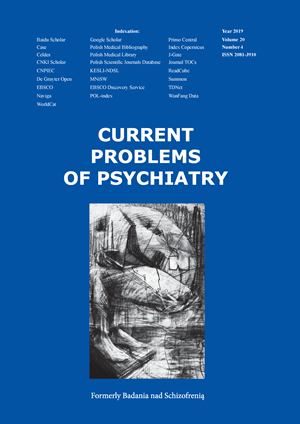Obesity and body image
DOI:
https://doi.org/10.2478/cpp-2019-0022Keywords:
body image, obesity.Abstract
Introduction: The opinion prevailing in western culture is that overweight people should be ashamed of their weight and looks. The idea is supported by the way the society perceives overweight people. Evidence that obesity is associated with chronic illness and a short life span is the main justification. However, the distorted body image does not seem to facilitate weight control.
Source and method: The purpose of the thesis is to present obese people body image. To present the data, the following electronic databases have been searched: PubMed, Elsevier, Cochrane Library. The bibliographic analysis of the selected studies has also been performed. The systematic literature search has been performed with the use of the following key words: “obesity” OR “overweight” AND “body image” OR “body dissatisfaction” OR “body acceptance” OR “body image”.
Discussion: We present a discussion of the results obtained.
Conclusions: The research indicates that negative body image can actually contribute to obesity-related health problems. Overweight and obese people, who accept their body weight, experience less physically and mentally “bad” days than people who are dissatisfied with their weight. Body dissatisfaction was identified as a psychological corellator of obesity related with eating disorders, low self-esteem and depression. However, not all obese people are equally affected by these correlates. "Normative dissatisfaction" also occurs in people with normal body weight. In this context, the complex correlation between body image and individual body weight seems to be a valuable research direction.
References
1. Schilder P. The image and appearance of the human body. New York International Universities Press, za: Brytek-Matera A., Charzyńska E. Związek pomiędzy niezadowoleniem z ciała i zmiennymi psychospołecznymi współwystępującymi z zaburzeniami odżywiania. Roczniki Psychologiczne, 2009; XII (2): 129-150.
2. Stewart, T.M, Williamson, D.A. Assessment of body image disturbance. W: Thompson J .K. red., H and book of eating disorders and obesity. New York; Wiley: 2 003: 4 95-514. za: Stetkiewicz-Lewandowicz A., Marciniak M., Sobów T. Wizerunek ciała w opinii studentek łódzkich uczelni wyższych. Psychological Journal, 2017; 23 (2): 377.
3. Brytek-Matera A. Obraz ciała-Obraz siebie. Warszawa; Difin: 2008.
4. Głębocka A., Kulbat, J. Wizerunek ciała Portret Polek. Opole; Wydawnictwo Uniwersytetu Opolskiego: 2005.
5. Schier, K. Piękne brzydactwo. Psychologiczna problematyka obrazu ciała i jego zaburzeń. Warszawa; Wydawnictwo Naukowe Schola: 2009.
6. Cash T.F., Pruzinsky, T. red., Body image. A handbook of theory, research, and clinical practice. New York; The Guilford Press: 2002.
7. Jośko-Ochojska J., Marcinkowska U., Lau K. Wygląd, samoocena i kształtowanie własnego ciała jako czynniki ryzyka anoreksji psychicznej u studentów. Ann Acad Med Gedan, 2013; 43 (1): 45-52.
8. Villon F. Wielki testament. Tłum. Boy-Żeleński T. (cytowane 30.07.2019). https://wolnelektury.pl/katalog/lektura/wielkitestament.html.
9. Singh P. Waist-to-hip ratio and judgment of attractiveness and healthiness of female figures by male and female physicians. Int J Obes Relat Metab Disord, 1994; 18 (11): 731-737.
10. Fisher S. The evolution of psychological concepts about the body. W: Cash T.F., Pruzinsky T. red., Body images: Development, deviance, and change. New York; Guilford Press: 1990: 3-20; za: Cash T. F. Body image: past, present, and future. Body Image 2004; 1; 1–5. https://doi.org/10.1016/S1740-1445(03)00011-1
11. Fisher S .: Development and structure of the body image. New Jersey; Lawrence Erlbaum Associates: 1986 (cytowane 26.08.2019). https://onlinelibrary.wiley.com/doi/abs/10.1002/
12. Fisher, S., Cleveland, S. E. Body image and personality. New York; Dover Publications: 1968.
13. Shontz, F.C. Perceptual and cognitive aspects of body experience. New York; Macmillan: 1969.
14. Shontz F.C. Body image and physical disability. W: Cash T.F., Pruzinsky T. red. Body images: Development, deviance, and change. New York; Guilford Press: 1990: 149–169.
15. Murawska M., Tajemnica żywej cielesności. Fenomenologia ciała w ujęciu Maurice’a Merleau-Ponty’ego i Michaela Henry’ego. Sztuka i Filozofia, 2008; 33: 127-144.
16. de Beauvoir S. Druga płeć. tłum. Gabriela Mycielska, Maria Leśniewska. Warszawa; Wydawnictwo Jacek Santorski & Co: 2003: 81.
17. Makara-Studzińska M., Zaborska A. Otyłość a obraz własnego ciała. Psychiatr Pol, 2009; XLIII (1): 109-114.
18. Sarwer D.B., Thompson J.K., Cash T.F. Body image and obesity in adulthood. Psychiatr Clin North Am, 2005; 28: 69-87. https://doi.org/10.1016/j.psc.2004.09.00215733612
19. Stunkard A, Mendelson M. Obesity and the body image. 1. Characteristics of disturbances in the body image of some obese persons. Am J Psychiatry 1967; 123: 1296–1300. https://doi.org/10.1176/ajp.123.10.12966021701
Downloads
Published
Issue
Section
License
Copyright (c) 2019 Authors

This work is licensed under a Creative Commons Attribution-NonCommercial-NoDerivatives 3.0 Unported License.


